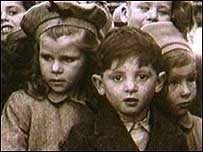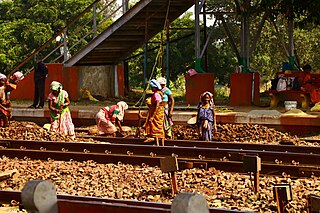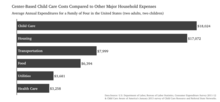
Foster care is a system in which a minor has been placed into a ward, group home, or private home of a state-certified caregiver, referred to as a "foster parent", or with a family member approved by the state. The placement of a "foster child" is normally arranged through the government or a social service agency. The institution, group home, or foster parent is compensated for expenses unless with a family member. In some states, relative or "Kinship" caregivers of children who are wards of the state are provided with a financial stipend.

Child care, otherwise known as day care, is the care and supervision of a child or multiple children at a time, whose ages range from two weeks of age to 18 years. Although most parents spend a significant amount of time caring for their child(ren), child care typically refers to the care provided by caregivers that are not the child's parents. Child care is a broad topic that covers a wide spectrum of professionals, institutions, contexts, activities, and social and cultural conventions. Early child care is an equally important and often overlooked component of child's developments.

The working poor are working people whose incomes fall below a given poverty line due to low-income jobs and low familial household income. These are people who spend at least 27 weeks in a year working or looking for employment, but remain under the poverty threshold.
A form of child abuse, child neglect is an act of caregivers that results in depriving a child of their basic needs, such as the failure to provide adequate supervision, health care, clothing, or housing, as well as other physical, emotional, social, educational, and safety needs. All societies have established that there are necessary behaviours a caregiver must provide for a child to develop physically, socially, and emotionally. Causes of neglect may result from several parenting problems including mental disorders, unplanned pregnancy, substance use disorder, unemployment, over employment, domestic violence, and, in special cases, poverty.
The United States Children's Bureau is a federal agency organized under the United States Department of Health and Human Services' Administration for Children and Families. Today, the bureau's operations involve improving child abuse prevention, foster care, and adoption. Historically, its work was much broader, as shown by the 1912 act which created and funded it:
The said bureau shall investigate and report to [the Department of Commerce and Labor] upon all matters pertaining to the welfare of children and child life among all classes of our people, and shall especially investigate the questions of infant mortality, the birth-rate, orphanage, juvenile courts, desertion, dangerous occupations, accidents and diseases of children, employment, legislation affecting children in the several states and territories.

Pre-kindergarten is a voluntary classroom-based preschool program for children below the age of five in the United States, Canada, Turkey and Greece. It may be delivered through a preschool or within a reception year in elementary school. Pre-kindergartens play an important role in early childhood education. They have existed in the US since 1922, normally run by private organizations. The U.S. Head Start program, the country's first federally funded pre-kindergarten program, was founded in 1967. This attempts to prepare children to succeed in school.
Kinship care is a term used in the United States and Great Britain for the raising of children by grandparents, other extended family members, and unrelated adults with whom they have a close family-like relationship such as godparents and close family friends because biological parents are unable to do so for whatever reason. Legal custody of a child may or may not be involved, and the child may be related by blood, marriage, or adoption. This arrangement is also known as "kincare" or "relative care." Kinship placement may reduce the number of home placements children experience; allow children to maintain connections to communities, schools, and family members; and increase the likelihood of eventual reunification with birth parents. It is less costly to taxpayers than formal foster care and keeps many children out of the foster care system. "Grandfamily" is a recently coined term in the United States that refers to families engaged in kinship care.
Early childhood intervention (ECI) is a support and educational system for very young children who have been victims of, or who are at high risk for child abuse and/or neglect as well as children who have developmental delays or disabilities. Some states and regions have chosen to focus these services on children with developmental disabilities or delays, but Early Childhood Intervention is not limited to children with these disabilities.
Early Head Start is a federally funded community-based program for low-income families with pregnant women, infants, and toddlers up to age 3. It is a program that came out of Head Start. The program was designed in 1994 by an Advisory Committee on Services for Families with Infants and Toddlers formed by the Secretary of Health and Human Services. "In addition to providing or linking families with needed services—medical, mental health, nutrition, and education—Early Head Start can provide a place for children to experience consistent, nurturing relationships and stable, ongoing routines."
Family preservation was the movement to help keep children at home with their families rather than in foster homes or institutions. This movement was a reaction to the earlier policy of family breakup, which pulled children out of unfit homes. Extreme poverty alone was seen as a justified reason to remove children. This new movement began in the 1890s, and in the 1909 White House Conference on Children it was the top ranked issue. In order to keep families together, the family would be given enough money so that the mother would not have to work a full-time job. The families that were given this assistance were usually headed by widows.
The Ohio Department of Job and Family Services (ODJFS) is the administrative department of the Ohio state government responsible for supervising the state's public assistance, workforce development, unemployment compensation, child and adult protective services, adoption, child care, and child support programs. Prior to July 2013, ODJFS was also the state agency responsible for the administration of Ohio's Medicaid program. In July 2013, a new state agency was created, the Ohio Department of Medicaid (ODM), Ohio’s first Executive-level Medicaid agency. ODJFS employs about 2,300 full time employees and has an annual budget of $3.3 billion.
The Missouri Department of Social Services (DSS) is a state agency of Missouri. It has its headquarters in the Broadway State Office Building in Jefferson City. The department operates the state's social services.
Work–family balance in the United States differs significantly for families of different social class. This differs from work–life balance: while work–life balance may refer to the health and living issues that arise from work, work–family balance refers specifically to how work and families intersect and influence each other.
Welfare in California consists of federal welfare programs—which are often at least partially administered by state and county agencies—and several independent programs, which are usually administered by counties.

The Wisconsin Department of Children and Families (DCF) is an agency of the Wisconsin state government responsible for providing services to assist children and families and to oversee county offices handling those services. This includes child protective services, adoption and foster care services, and juvenile justice services. It also manages the licensing and regulation of facilities involved in the foster care and day care systems, performs background investigations of child care providers, and investigates incidents of potential child abuse or neglect. It administers the Wisconsin Works (W-2) program, the child care subsidy program, child support enforcement and paternity establishment services, and programs related to the federal Temporary Assistance to Needy Families (TANF) income support program.
New Zealand suffers from one of the highest rates of child poverty in the Western world. Child poverty affects 12% of children in New Zealand, as of the year ended June 2022 according to Statistics New Zealand. The number in 2011 was 285,000, as reported by the Child Poverty Action Group (CPAG). As inequality increased during the mid-2010s, this figure increased to an estimated 295,000 children in 2016, around one in six children in New Zealand. Child poverty has a disproportionately high effect on in Māori and Pasifika households, with 23.3% of Māori children and 28.6% of Pacific children living in poverty. These two ethnic groups struggle particularly due to the lingering effects of forced land alienation and immigration discrimination respectively. The Ministry of Social Development recognises that:
Poverty in the richer nations is about relative disadvantage—it is about households and individuals who have a day-to-day standard of living or access to resources that fall below a minimum acceptable community standard.
A large proportion of children in the United States experience poverty. As of 1992, children were the largest age group living below the poverty line, and around 1 in 5 children were affected as of 2016. Child poverty is measured using absolute and relative methods. It is caused by many factors, including race, education, and family structure, but ultimately race correlates with these factors. There are multiple effects due to this. Effects on health and development cause lifelong problems and lower educational outcomes, and food insecurity can also be caused by child poverty. The United States government has put in place programs using tax credits and transfers. There are also community programs that have impacted specific communities that have high child poverty rates. For future policies, research suggests that greater investment directed to children and families in poverty and connections between healthcare providers and financial services can lower the child poverty rate.

The New York City Administration for Children's Services (ACS) is a New York City government agency that protects and promotes safety and the well-being of New York City's children and families by providing child welfare, juvenile justice, and early care and education services.
Residential child care communities or children's homes are a type of residential care, which refers to long-term care given to children who cannot stay in their birth family home. There are two different approaches towards residential care: The family model and the shift care model.
Early childhood education in the United States relates to the teaching of children from birth up to the age of eight. The education services are delivered via preschools and kindergartens.






